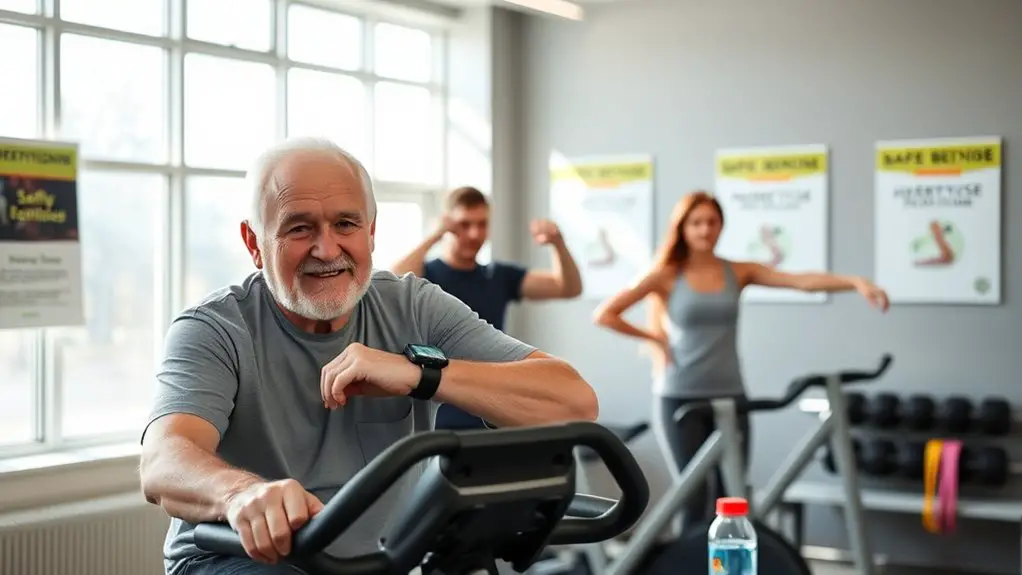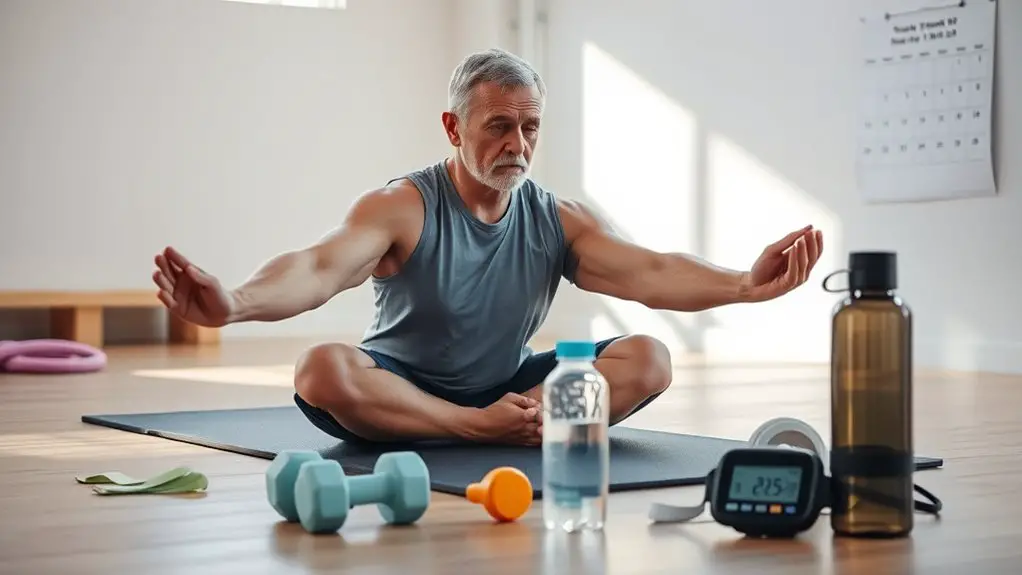How to Train With Hypertension at the Gym

To train with hypertension at the gym, consult your healthcare provider first to get a tailored exercise plan. Focus on low-impact aerobic exercises like walking or cycling, and incorporate strength training safely. Monitor your heart rate, aiming for moderate intensity, and listen to your body’s signals. Stay hydrated and prioritize a balanced diet, rich in fruits and whole grains. Remember to progress gradually and acknowledge your limits. There’s more to explore about safe exercise practices.
Understanding Hypertension and Its Impact on Exercise

When you have hypertension, understanding how it affects your exercise routine is vital for your health and safety. Hypertension symptoms, such as headaches or fatigue, can impact your ability to engage in physical activity. However, regular exercise offers significant benefits, including improved cardiovascular health and reduced blood pressure.
It’s important to choose the right types of workouts that align with your condition. Low-impact exercises, like walking, cycling, or swimming, can be particularly effective and easier on your body. These activities can help you manage stress and promote overall well-being.
Listen to your body—if you experience any hypertension symptoms during exercise, it’s important to stop and rest. Gradually increasing your intensity can help you avoid complications while still enjoying the numerous exercise benefits. By staying informed and mindful, you can create a safe and effective fitness routine that supports your health goals.
Consult Your Healthcare Provider
Before starting any exercise program, it’s essential to consult your healthcare provider, especially with hypertension. They can provide medical clearance and discuss how your medications might affect your training and overall health. This step guarantees you’re making informed decisions that prioritize your safety while working toward your fitness goals.
Importance of Medical Clearance
Consulting your healthcare provider is essential if you have hypertension and plan to start a gym routine. A thorough medical evaluation guarantees that your exercise plan is tailored to your unique needs, considering your health history and any potential risks. Your provider can assess your current condition, recommend appropriate activities, and help you determine safe intensity levels. They may also provide guidance on monitoring your blood pressure during workouts. Taking this step not only enhances your safety but also boosts your confidence as you begin your fitness journey. Remember, being proactive about your health can lead to better outcomes, so don’t hesitate to reach out and discuss your plans with your healthcare provider.
Discuss Medication Effects
Understanding how your medications affect your ability to exercise is vital, especially if you have hypertension. Different medication types, such as diuretics or beta-blockers, can influence your heart rate, blood pressure, and overall stamina. It’s important to be aware of these effects when planning your workout routine. For instance, certain medications may cause dizziness or fatigue, particularly at higher dosage effects. This might require adjusting your exercise intensity or duration. Always consult your healthcare provider for personalized advice on how to manage your training safely. They can help you understand how your specific medications interact with physical activity and guarantee your fitness goals align with your health needs. Prioritizing safety will lead to a more effective and enjoyable workout experience.
Choose the Right Type of Exercise

When it comes to exercising with hypertension, selecting the right type of activity can make all the difference in maintaining your health and safety. Focus on incorporating aerobic exercises into your routine, as these activities help improve cardiovascular health without putting excessive strain on your body. Walking, swimming, or cycling are excellent options that can elevate your heart rate while still being manageable.
Additionally, don’t underestimate the importance of flexibility training. Incorporating stretching exercises can improve your overall mobility and reduce the risk of injury. Yoga and Pilates are great choices, as they promote relaxation and can help lower stress levels, which is vital for managing hypertension.
Always listen to your body and make modifications as needed. Remember, the goal is to stay active while prioritizing your well-being. Consult your healthcare provider before starting any new exercise program to guarantee it’s tailored to your specific condition.
Monitor Your Heart Rate
Monitoring your heart rate is a key component of exercising safely with hypertension. By keeping track of your heart rate, you can better manage your exercise intensity and guarantee you’re within a safe range. Aim for a moderate level of intensity, typically around 50-70% of your maximum heart rate, which you can calculate by subtracting your age from 220.
Using a heart rate monitor—whether a wearable device or an app—makes it easier to stay aware of your heart rate during workouts. Regular heart rate monitoring can help you recognize how your body responds to different exercises and adjust your routine accordingly. If your heart rate exceeds the recommended range, it’s essential to slow down or take a break. This proactive approach not only enhances your workout experience but also contributes to overall cardiovascular health, making exercise safer and more effective for you.
Start Slowly and Progress Gradually

Starting your workout routine with hypertension requires a careful approach, as jumping into intense exercise too quickly can put unnecessary strain on your heart. To safely build your fitness level, focus on warm-up routines and set incremental goals. Begin with light activities, gradually increasing intensity as your body adapts.
| Week | Activity Level | Incremental Goal |
|---|---|---|
| 1 | 10-15 min walking | Establish routine |
| 2 | 15-20 min walking | Add light stretching |
| 3 | 20-25 min brisk walking | Increase pace |
| 4 | 25-30 min walking | Try gentle yoga |
| 5 | 30-35 min walking | Maintain consistency |
Incorporate Strength Training Safely
When incorporating strength training into your routine, it’s crucial to choose low-impact exercises that are easier on your joints. Additionally, keep a close eye on your heart rate to guarantee you’re staying within a safe range. This approach will help you build strength while managing your hypertension effectively.
Choose Low-Impact Exercises
Choosing low-impact exercises is essential for individuals with hypertension, as these workouts can minimize strain on the heart while still providing effective strength training. Incorporating low-impact activities helps improve your overall fitness without overexerting yourself. Here are some options to evaluate:
- Resistance Bands: They offer adjustable resistance and are gentle on your joints.
- Bodyweight Exercises: Movements like squats and lunges can build strength without heavy weights.
- Water Aerobics: These aerobic activities reduce impact while providing resistance for a full-body workout.
- Yoga or Pilates: Flexibility exercises enhance mobility and reduce stress, benefiting both body and mind.
Monitor Heart Rate
Incorporating strength training into your routine can be beneficial for managing hypertension, but it’s important to monitor your heart rate to confirm you’re exercising safely. Start by determining your target heart rate, which is typically 50-85% of your maximum heart rate. Use monitoring techniques like wearable fitness trackers or checking your pulse manually during workouts. This helps confirm you stay within a safe range while lifting weights. If your heart rate exceeds your target, take a break or reduce the intensity. Remember, consistency is key, so aim for regular strength training sessions while keeping an eye on your heart rate. By doing so, you can effectively enhance your fitness while managing hypertension.
Stay Hydrated and Mind Your Nutrition

Staying hydrated and minding your nutrition are essential aspects of managing hypertension, especially when you’re hitting the gym. Proper hydration and nutrition choices can greatly impact your performance and overall health. Here are some hydration tips and nutrition strategies to keep in mind:
- Drink Water Regularly: Aim for at least 8-10 cups of water daily, adjusting for exercise intensity.
- Opt for Low-Sodium Foods: Choose fresh fruits, vegetables, and whole grains to help manage your sodium intake.
- Include Potassium-Rich Foods: Incorporate bananas, sweet potatoes, and spinach, as potassium can help balance sodium levels.
- Limit Processed Sugar: Reduce sugary snacks and drinks, which can lead to weight gain and increased blood pressure.
Listen to Your Body and Know Your Limits
While hydration and nutrition set the foundation for your workouts, listening to your body is just as important when managing hypertension. Developing body awareness is vital; it helps you recognize how your body reacts to different exercises. Pay attention to any signs of fatigue, dizziness, or unusual discomfort. If you notice these symptoms, it’s essential to stop and reassess your routine.
Limit recognition is another key aspect of training safely. Know your physical boundaries and don’t push yourself beyond them. Gradually increase intensity and volume, allowing your body time to adapt. Remember, it’s perfectly okay to modify exercises or take breaks as needed.
Frequently Asked Questions
Can I Participate in Group Fitness Classes With Hypertension?
Yes, you can participate in group fitness classes with hypertension, but it’s important to make some fitness modifications. Choose classes that focus on low-impact exercises, like yoga or cycling, which can be easier on your heart. Communicate your condition to the instructor so they can provide specific modifications. Staying hydrated and monitoring your heart rate during workouts are also key. Always consult with your healthcare provider before starting any new fitness routine.
What Should I Do if I Feel Dizzy During Exercise?
Did you know that nearly 30% of people experience dizziness during exercise at some point? If you feel dizzy, stop immediately and sit down to prevent falls. Common dizziness causes include dehydration and low blood sugar, so make certain you’re well-hydrated and have eaten adequately before working out. Recovery strategies like deep breathing and resting can help. If dizziness persists, consult a healthcare professional to rule out any underlying issues.
Are There Specific Exercises to Avoid With Hypertension?
When managing hypertension, it’s wise to avoid high intensity workouts that can spike your blood pressure. Instead, focus on moderate exercises. In strength training, steer clear of heavy lifting and exercises that require straining, like deadlifts or squats with excessive weight. Incorporate lighter weights with higher repetitions to build strength safely. Always listen to your body, and consult a healthcare professional for personalized guidance on what exercises are best for you.
How Often Should I Check My Blood Pressure While Exercising?
Just like a ship needs constant navigation, you should monitor your blood pressure regularly while exercising. Blood pressure guidelines suggest checking it before, during, and after your workout. This monitoring frequency helps you gauge your body’s response to exercise and guarantees you’re staying within safe limits. If you notice any significant spikes or symptoms, it’s vital to stop and consult a healthcare professional. Your safety should always come first!
Can I Use Supplements to Manage Hypertension During Workouts?
You might be considering supplements to manage hypertension during workouts. While some supplements claim benefits, it’s important to prioritize natural remedies and dietary adjustments first. Incorporating foods rich in potassium and magnesium can support heart health. Always consult a healthcare professional before starting any supplement, as they can interact with medications or cause side effects. Staying hydrated and managing stress are also vital in maintaining healthy blood pressure levels while you exercise.





